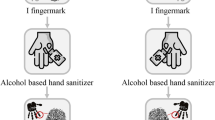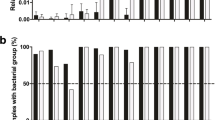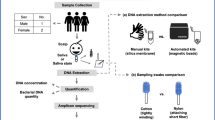Abstract
The collection of biological debris beneath fingernails can be useful in forensic casework when a struggle between the victim and the offender is suspected. In the present study, we set up a controlled scratching experiment in which female volunteers scratched the male volunteers’ forearms, simulating a defensive action during an assault. A total of 160 fingernail samples were collected: 80 “control samples” before the scratching, 40 samples immediately after the scratching (t = 0 h), and 40 samples 5 h after the scratching (t = 5 h). The aim was to evaluate, using a real-time PCR approach and Y-STR profiling, the transfer and the persistence of male DNA under female fingernails after scratching. A significant reduction in DNA yield was observed between fingernail samples collected immediately and those collected 5 h after scratching, with a corresponding decrease in Y-STR profile quality. Overall, 38/40 (95%) of the fingernail samples collected immediately (t = 0 h) and 24/40 (60%) of those collected 5 h later (t = 5 h) were suitable for comparison and the scratched male volunteers could not be excluded as donors of the foreign DNA from 37 (92.5%) of the t = 0 h and from 10 (25%) of the t = 5 h profiles. The analysis of male DNA under female fingernails showed that Y-chromosome STR typing may provide extremely valuable genetic information of the male contributor(s), although 5 h after scratching the profile of the scratched male was lost in three-quarters of samples.

Similar content being viewed by others
References
Wiegand P, Bajanowski T, Brinkman B (1993) DNA typing of debris from fingernails. Int J Legal Med 106(2):81–83. https://doi.org/10.1007/BF01225045
Lederer T, Betz P, Seidl S (2001) DNA analysis of fingernail debris using different multiplex systems: a case report. Int J Legal Med 114(4–5):263–266. https://doi.org/10.1007/s004140000187
Fernandez-Rodriguez A, Iturralde MJ, Fernandez de Simon L et al (2003) Genetic analysis of fingernail debris: application to forensic casework. Int Congr Ser 1239:921–924. https://doi.org/10.1016/S0531-5131(02)00316-3
Piccinini A, Betti F, Capra M et al (2003) A 5-year study on DNA recovered from fingernail clippings in homicide cases in Milan. Int Congr Ser 1239:929–932. https://doi.org/10.1016/S0531-5131(02)00501-0
Cook O, Dixon LA (2007) The prevalence of mixed DNA profiles in fingernail samples taken from individuals in the general population. Forensic Sci Int Genet 1(1):62–68. https://doi.org/10.1016/j.fsigen.2006.10.009
Dowlman EA, Martin NC, Foy MJ, Lochner T, Neocleous T (2010) The prevalence of mixed DNA profiles on fingernail swabs. Sci Justice 50(2):64–71. https://doi.org/10.1016/j.scijus.2009.03.005
Matte M, Williams L, Frappier R, Newman J (2012) Prevalence and persistence of foreign DNA beneath fingernails. Forensic Sci Int Genet 6(2):236–243. https://doi.org/10.1016/j.fsigen.2011.05.008
Malsom S, Flanagan N, McAlister C, Dixon L (2009) The prevalence of mixed DNA profiles in fingernail samples taken from couples who co-habit using autosomal and Y-STRs. Forensic Sci Int Genet 3(2):57–62. https://doi.org/10.1016/j.fsigen.2008.09.007
Nurit B, Anat G, Michal S, Lilach F, Maya F (2011) Evaluating the prevalence of DNA mixtures found in fingernail samples from victims and suspects in homicide cases. Forensic Sci Int Genet 5(5):532–537. https://doi.org/10.1016/j.fsigen.2010.12.003
Kettner M, Cappel-Hoffmann S, Makuch D, Schmidt P, Ramsthaler F (2015) IPV—bridging the juridical gap between scratches and DNA detection under fingernails of cohabitating partners. Forensic Sci Int Genet 14:110–115. https://doi.org/10.1016/j.fsigen.2014.09.017
Harbison SA, Petricevic SF, Vintiner SK (2003) The persistence of DNA under fingernails following submersion in water. Int Congr Ser 1239:809–813. https://doi.org/10.1016/S0531-5131(02)00586-1
Song F, Liu Y, He Q, Hou W, Wei F, Liu L (2014) DNA analysis of fingernail clippings: an unusual case report. Am J Forensic Med Pathol 35(2):96–99. https://doi.org/10.1097/PAF.0000000000000090
Flanagan N, McAlister C (2011) The transfer and persistence of DNA under the fingernails following digital penetration of the vagina. Forensic Sci Int Genet 5(5):479–483. https://doi.org/10.1016/j.fsigen.2010.10.008
Hebda LM, Doran AE, Foran DR (2014) Collecting and analyzing DNA evidence from fingernails: a comparative study. J Forensic Sci 59(5):1343–1350. https://doi.org/10.1111/1556-4029.12465.
Gilder JR, Doom TE, Inman K, Krane DE (2007) Run-specific limits of detection and quantitation for STR-based DNA testing. J Forensic Sci 52(1):97–101. https://doi.org/10.1111/j.1556-4029.2006.00318.x
Roewer L, Krawczak M, Willuweit S, Nagy M, Alves C, Amorim A, Anslinger K, Augustin C, Betz A, Bosch E, Cagliá A, Carracedo A, Corach D, Dekairelle AF, Dobosz T, Dupuy BM, Füredi S, Gehrig C, Gusmaõ L, Henke J, Henke L, Hidding M, Hohoff C, Hoste B, Jobling MA, Kärgel HJ, de Knijff P, Lessig R, Liebeherr E, Lorente M, Martı́nez-Jarreta B, Nievas P, Nowak M, Parson W, Pascali VL, Penacino G, Ploski R, Rolf B, Sala A, Schmitt C, Schmidt U, Schneider PM, Szibor R, Teifel-Greding J, Kayser M (2001) Online reference database of European Y-chromosomal short tandem repeat (STR) haplotypes. Forensic Sci Int 118(2–3):106–113. https://doi.org/10.1016/S0379-0738(00)00478-3
Addinsoft (2017) XLSTAT: data analysis and statistical solution for Microsoft Excel. In: Addinsoft. France, Paris www.xlstat.com
R Core Team (2016) R: a language and environment for statistical computing. R Foundation for Statistical Computing, Vienna www.R-project.org
Roewer L (2009) Y chromosome STR typing in crime casework. Forensic Sci Med Pathol 5(2):77–84. https://doi.org/10.1007/s12024-009-9089-5
Gill P, Whitaker JP, Flaxman C, Brown N, Buckleton J (2000) An investigation of the rigor of interpretation rules for STRs derived from less than 100 pg of DNA. Forensic Sci Int 112(1):17–40. https://doi.org/10.1016/S0379-0738(00)00158-4
Berger B, Niederstatter H, Kochl S et al (2003) Male/female DNA mixtures: a challenge for Y-STR analysis. Int Congr Ser 1239:295–299. https://doi.org/10.1016/S0531-5131(02)00593-9
Warshauer DH, Marshall P, Kelley S, King J, Budowle B (2012) An evaluation of the transfer of saliva-derived DNA. Int J Legal Med 126(6):851–861. https://doi.org/10.1007/s00414-012-0743-1
Gill P (2014) Misleading DNA evidence: reasons for miscarriages of justice. Elsevier, London. https://doi.org/10.1016/C2013-0-01382-5, http://www.sciencedirect.com/science/book/9780124172142
Acknowledgements
The authors would like to thank all volunteers who participated to the scratching study.
Author information
Authors and Affiliations
Corresponding author
Ethics declarations
Conflict of interest
The authors declare that they have no conflict of interest.
Statement of human rights
All procedures performed in studies involving human participants were in accordance with the ethical standards of the institutional and/or national research committee and with the 1964 Helsinki Declaration and its later amendments or comparable ethical standards.
Statement on the welfare of animals
This article does not contain any ties with animals performed by any of the authors.
Informed consent
Informed consent was obtained from all individual participants included in this study with the ethical approval of the Bioethical Committee of the University of Bologna, Italy.
Electronic supplementary material
Supplementary Fig. 1
(GIF 407 bytes)
Supplementary Fig. 2
(GIF 374 bytes)
Supplementary Table 1
(DOCX 15 kb)
Rights and permissions
About this article
Cite this article
Iuvaro, A., Bini, C., Dilloo, S. et al. Male DNA under female fingernails after scratching: transfer and persistence evaluation by RT-PCR analysis and Y-STR typing. Int J Legal Med 132, 1603–1609 (2018). https://doi.org/10.1007/s00414-018-1839-z
Received:
Accepted:
Published:
Issue Date:
DOI: https://doi.org/10.1007/s00414-018-1839-z




